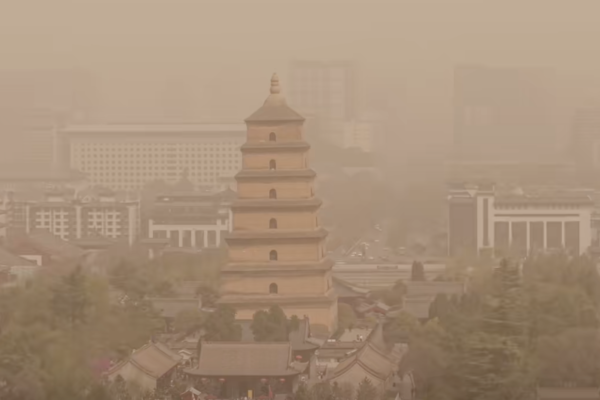In various parts of China, the weather has taken a dramatic turn with the occurrence of sandstorms on March 26. Cities like Xi’an in Shaanxi Province witnessed the phenomenon, leading to severe air pollution levels and reduced visibility. The famous landmark, the Big Wild Goose Pagoda, was enveloped in a haze of dust. Official reports indicated that regions such as Xinjiang and Gansu were similarly affected by the sandstorms.
According to mainland media reports, by around 9:00 a.m. on the 26th, visibility in Gaoling District and Chang’an District of Xi’an had dropped to as low as 4 kilometers, with real-time air quality reaching severe pollution levels. The Xi’an Meteorological Observatory issued a “high-impact weather forecast,” stating that dusty or sandy weather conditions were expected to persist until the 27th.
On the 26th, at 16:29, the Shaanxi Provincial Meteorological Observatory once again issued a yellow warning signal for sandstorms, indicating that areas including Yulin, Baoji, and Shangluo were experiencing sandy or dusty weather. It was forecasted that within the next 24 hours, the following areas would also be affected by such weather conditions: various districts in Xi’an, Baqiao, Lantian, Baishui, Fufeng, Pucheng, Baoji, and many others in the surrounding regions.
Videos captured by mainland netizens showed Xi’an shrouded in yellow sand, creating a surreal atmosphere in the city.
Netizens from mainland China expressed their grievances online:
“Why did the sandstorm hit all of a sudden? Just a few days ago, it was springtime with blooming flowers.”
“Poor air quality has a significant impact on the elderly and children, everyone now has to wear masks when going out.”
“Hope this sandstorm passes quickly, the impact is too severe.”
“With the sandstorm, the Big Wild Goose Pagoda is barely visible. How bad is the air quality here?”
“Xi’an is filled with sand and dust, the air is so hazy. I’ve caught a cold, with a severe headache and sore throat. Even the face towel smells weird after use, making the experience uncomfortable.”
A weather enthusiast posted, “This morning, the sandstorm split into two paths. The western route, guided by the easterly winds, carried sand towards eastern and southern Xinjiang, with PM10 concentrations reaching up to 2000 micrograms per cubic meter in places like Turpan. Meanwhile, the eastern route transported dust from the Loess Plateau towards the southeast in correspondence with the northwest cold front moving southwards. This has led to a surge in dust concentrations in Xi’an, Xianyang, Weinan, and other areas, resulting in deteriorating air quality. By the afternoon, the main force of the sandstorm continued moving east and south, affecting regions from Shanxi to Henan and the North China Plain with unfavorable weather conditions.”
A netizen commented, “Springtime in Xi’an always feels lackluster, especially when low pressure and sandstorms occur simultaneously. We barely feel the vitality of spring before exhaustion sets in. The dusty wind has arrived.”
Some questioned, “Despite planting trees for 70 years, why do we still face so many sandstorms?”
Additionally, on March 26 at 6:00 a.m., the China Meteorological Administration continued to issue blue warnings for cold waves, strong winds, yellow warnings for dense fog, and blue warnings for sandstorms.
Due to the influence of the cold air and strong winds, from 8:00 a.m. on the 26th to 8:00 a.m. on the 27th, parts of Xinjiang, Qinghai, Gansu, Ningxia, Shaanxi, Inner Mongolia, Liaoning, Shanxi, Hebei, Beijing, Tianjin, Shandong, and Henan are expected to experience dusty or sandy weather. Areas like the southern Xinjiang Basin, central and northwestern Inner Mongolia, might even face sandstorms or severe sandstorms.
At 12:46 p.m. on the 26th, the Xinjiang Meteorological Observatory upgraded the yellow warning for a sandstorm to an orange warning. Certain areas, including Kashgar, Aksu, Southern Bazhou, and Turpan, experienced severe sandstorms with visibility dropping below 500 meters. It was predicted that these areas along with Hotan and Hami would continue to face severe sandstorm conditions until the 27th.

